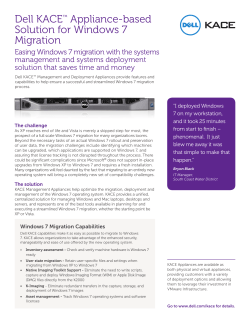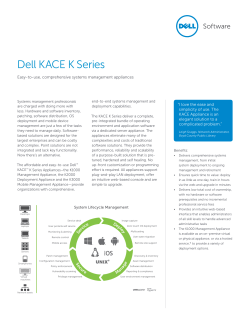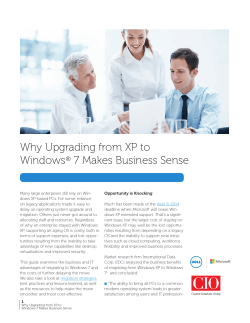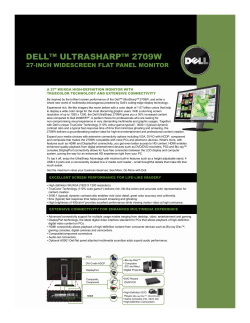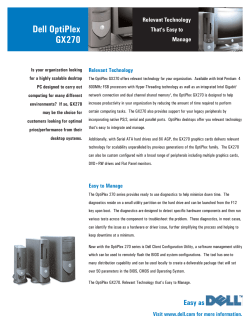
Migrating from Windows XP Understanding the Challenges—and How to Mitigate Them Abstract
Migrating from Windows XP Understanding the Challenges—and How to Mitigate Them Written by Dell Software Abstract Microsoft® has announced that extended support for Windows® XP will end on April 8, 2014. But because migrating to a new operating system can be a time-consuming and error-prone process, many organizations have yet to complete—or even start—the process. Such a delay is a bad idea: when Microsoft support ends, organizations still running Windows XP will be exposed to increased security risks, support challenges and costs. This paper describes how effective migration projects can be broken down into four manageable phases, and how industry best practices and products from Dell’s endpoint systems management group—including the Dell™ KACE™ K1000 Management Appliance, Dell KACE K2000 Deployment Appliance, and Dell ChangeBASE application readiness solution—can reduce the time and disruption caused by a migration from XP to Windows 7 or 8, as well as provide IT more time and resources to focus on more strategic initiatives. Since operating system migration projects typically take 12 to 24 months to complete, there is simply not enough time to migrate to a new operating system using a manual approach. Fortunately, organizations can still complete their migrations in time—by learning what has and hasn’t worked for others, following industry best practices, and leveraging automation tools that are integrated and proven. Microsoft has announced that extended support for Windows XP will end on April 8, 2014. Organizations need to move to a supported version of Windows by that date or face increased security risks and support challenges. However, since migrating to a new operating system can be both time consuming and error prone, many companies have yet to complete—or even Introduction start—the migration process. In fact, a June 2013 surveyi of 467 IT professionals by Dimensional Research found that only 37 percent of respondents’ organizations had completely moved off of Windows XP, and 31 percent had yet to set a target completion date. Of those that do have a target completion date, the schedules for 26 percent are beyond Microsoft’s end of support deadline. Worse, 16 percent of the respondents’ organizations haven’t even started their migration project. A recent Gartner studyii estimates that 15 percent of large enterprises will not complete their migration in time. “With the advent of Windows 7, understanding the nature of your application estate, and how each application will react in the environment, has become central to the success of the migration project.” Chris Jackson, Principal Consultant for Application Compatibility at Microsoft When Microsoft support ends, organizations still running Windows XP will face increasing security risks and support challenges that will consume IT resources and budgets: • An IDC studyiii warned that remaining on Windows XP is “a bad idea.” The IDC study found that supporting older Windows XP installations consumes more IT labor: $870 per XP system per year, versus $168 for comparable modern Windows 7 systems. • Obtaining custom Windows XP support from Microsoft will be expensive, and will include a charge per deployed patch per machine. First-year costs are estimated to be as high $150,000 for 750 PCs and as much as $5 million for organizations with 25,000 PCs. • Even with custom patches applied, an XP system is a higher security risk than an upto-date Windows 7 or Windows 8 system. • Compatibility problems for Windows XP systems will increase as well. Gartner estimates by the end of 2013, more than 60 percent of ISVs will offer software releases that are not supported on Windows XP.iv This paper describes how effective migration projects can be broken down into four manageable phases, based on the data gathered in the Dimensional Research survey. The lessons learned from those 467 IT professionals and industry best practices are applied to each phase to illustrate how to quickly, efficiently and cost effectively migrate to a supported version of Windows. Share: 2 What keeps companies from migrating? Migrating end-user systems to a new operating system is a lengthy (typically 12-24 months), error-prone process with many potential pitfalls. Over 86 percent of the Dimensional Research survey respondents reported encountering challenges during their projects. The top five issues in order of occurrence were: 1. Application compatibility problems 2. Time available to perform migration and conflicts with other IT initiatives 3. User training and support required after migration 4. Lost user productivity during migration 5. Issues with repackaging, remediating and deploying applications The common elements in these issues are applications and time. Some of the other survey answers provide further insight: • A large portion of the time spent on applications—More than half of the survey participants (53 percent) reported that at least half of the migration time was spent on installing and migrating applications. • Unused applications—Nearly half (48 percent) reported encountering applications that are deployed but are not used. A surprising 24 percent reported that less than half of their deployed applications are in use. Considering how much of the migration process is consumed by applications, spending time on unused applications is extremely wasteful. • Length of time to deploy a PC—73 percent indicated that it took longer than an hour to reimage and deploy a PC with the new operating system. That includes 37 percent who reported this process took more than two hours. Only 8 percent were able to migrate a PC in under 30 minutes. Much of the time is consumed in post-operating system install tasks such as installing patches and applications. • Too many system installation images—43 percent are maintaining five or more system installation images, and 24 percent maintain ten or more images. Keeping that many system images up to date is very labor intensive and error prone. Images can get stale during the migration process, leaving more patches to be installed post- installation. As a result, even more time is spent on each PC deployment. • Didn’t use outside expertise—Only 16 percent indicated their organizations utilized external expertise during their migration projects. However, more than a third (35 percent) of larger companies (those with more than 5,000 employees) did seek outside assistance. Smaller organizations (with fewer than 1,000 employees) were much less likely (only 11 percent) to use outside help. Application compatibility Application compatibility issues are a major concern in the migration process because Microsoft has made a number of significant improvements since Windows XP to simplify administration and improve security—improvements that affect application compatibility between Windows XP and the newer operating systems. The changes with the biggest impact are the User Account Control (UAC) security mechanism and the update user profile system. Many applications that were built specifically for Windows XP will not work 100 percent correctly out of the box on Windows 7 or Windows 8. According to Chris Jackson, principal consultant for Application Compatibility at Microsoft, “Application compatibility is the single biggest blocker to enterprise Windows 7 migration. With the advent of Windows 7, understanding the nature of your application estate, and how each application will react in the environment, has become central to the success of the migration project.” An analysis from actual migration projectsv found that only a third (34 percent) of applications had no compatibility issues when installed on Windows 7. Fortunately, 61 percent of the applications with compatibility issues could be addressed with minor updates or “tweaks.” Only 5 percent required a developer update, an upgrade to a new version, or the use of virtualization to provide access to the application in a Window XP virtual machine. Migrating an application to Windows 7 or Windows 8 requires compatibility testing, re-packaging, and usually some remediation for the 61 percent with minor compatibility issues. User acceptance testing (UAT) is needed to verify that the application actually functions correctly on the new system. This testing must be performed in conjunction with other packages, since there may be dependencies on components such as Microsoft Office, Internet Explorer, and document or media viewers. In addition, any changes made during the course of the project can necessitate re-testing some or all applications to find newly introduced incompatibilities. Testing, remediating and packaging a single application can easily take at least four hours. It’s not uncommon for a medium-sized organization to have more than 1,000 applications deployed. The labor needed for that many applications can be 18 to 24 person-months. Given the amount of time it takes and the potential for compatibility problems, it is important to focus only on applications that are actually needed and in use. Multiple outdated versions or redundant applications should not be migrated. Tools that automate compatibility assessment, remediation, packaging and deployment can greatly reduce the labor needed and have a significant impact on the success of the project. Reasons for failed migrations Reasons why migrations fail include application or hardware compatibility issues, missing or outdated drivers, and other software dependencies. The worst case is discovering that required applications are missing or that applications or hardware don’t work after spending hours on the migration of a user’s PC. These problems result in lost user productivity and a poor perception of IT and the migration project. The majority of problems can be detected and handled ahead of time by performing a thorough inventory and careful analysis of all hardware and software. Even with a careful inventory, Share: 3 Gartner reports that customers save 40 percent by deploying automated tools for compatibility assurance.vii things are likely to change and therefore be missed if too much time elapses before the actual migration is performed. In order for the data and the analysis to be effective, it must be both complete and up to date. Best practices for ensuring a smooth migration Considering the time required to test, remediate and repack an application, each application eliminated from the migration saves an average of $3,000. The work done at the beginning of the project, before any end-user systems are migrated, has the largest impact on the success of the project. This is the time to re-evaluate the current state and make improvements. Many organizations under time and resource pressures take the approach that migration is a one-time event and that they just need to get through it as quickly as possible, by brute force if necessary. This is a critical mistake. The decisions made at the onset will largely determine how ongoing support and maintenance of the new Windows environment will occur for the next several years. Selecting the correct tools to understand the current landscape and deploy systems will also lay the foundation for the management of the new environment. An effective migration project can be divided into four phases that make the entire process manageable and achievable: • Phase I—Planning: inventory, analysis, and rationalization • Phase II—Applications: testing, remediation, and repackaging • Phase III—Deployment: migration of systems and user content • Phase IV—Ongoing maintenance and support Automation can have a significant positive impact on each and every phase of the migration process. From obtaining a complete inventory and keeping it up to date, to assuring application compatibility and assessing the impact of potential changes, to deploying and patching systems and applications, using a suite of automation tools can easily reduce the amount of time and labor needed in half. The rest of this paper describes each phase, the best practices for that phase, and then discusses how Dell’s endpoint systems management products can help automate each phase to reduce the time Migrate applications and operating systems rapidly, accurately and securely with the Dell™ KACE™ management appliances and Dell ChangeBASE application readiness solution. Share: 4 and risks of the migration process and subsequent system maintenance. Phase I—Planning: Inventory, analysis and rationalization Best practice: Create and maintain a complete, up-to-date inventory of all hardware and applications, and who uses them. The first step in beginning a migration project is to create a complete inventory of all applications, hardware, users and groups. Be sure to discover and analyze the hardware characteristics of all existing PCs and peripherals to verify compatibility with the new version of Windows. A common cause of failures during migration is that incompatible peripherals or missing drivers are not detected during the inventory process. In addition to listing all applications, be sure to find out who uses them. It is common to find applications that are installed but no longer used, particularly older versions of applications. Another important piece of data to gather is the amount of valid data your users store on their desktops or laptops. This will help determine how long it will take to migrate the users’ local data. You need to keep the inventory up to date, since systems, applications and users are likely to change during the many months that a migration process can take. This means a manual inventory process alone is insufficient and will lead to oversights. How Dell can help: The Dell KACE K1000 is a fully-integrated systems management solution. The K1000 can build and maintain an inventory of all systems and software. The Dell KACE K2000 is used alongside the K1000 to fulfill system deployment needs, complementing the K1000’s inventory with details on all hardware and information on all device drivers in use. Together, the K1000 and K2000 provide a comprehensive set of reports that can be used for the next steps of analysis and rationalization. Best practice: Rationalize content so you only migrate what is actually used and necessary. Eliminate unused, outdated or redundant applications. Remove hardware and peripherals that are not used. Do not spend time migrating unsupported user content such as music and videos. Cleaning up and removing unused components through analysis and rationalization can significantly reduce the amount of effort required for the project. Data gathered from actual migration projects show that careful analysis can eliminate 50– to 90 percent of applications from the migration project. Dell’s own internal migration effort identified more than 10,000 applications during inventory and rationalized the list down to 3,000 that were actually needed. Considering the time required to test, remediate and repack an application, each application eliminated from the migration saves an average of $3,000. For most organizations, rationalization yields significant savings. How Dell can help: The Dell KACE appliances can provide valuable assistance with rationalization. The K1000 provides software metering data on who actually uses which applications, in both the current XP installation and the future Windows 7 or Windows 8 environment. The inventories produced by the K1000 and K2000 can help identify unused hardware components as well. In addition, K2000 migration templates help automate user state migration, including files, and can ensure that unsupported data such as mp3 files and videos are not migrated, reducing both the time and the effort required to migrate a system. Phase II—Applications: Testing, remediation and repackaging Best practice: Improve speed, quality, and consistency by automating application compatibility testing, remediation, and repackaging. Each application that needs to be migrated must be tested for compatibility with the new Windows Share: 5 “The ChangeBASE solution saved us 50 percent of our projected costs, and the migration took only half the time it would have required if we had done the application analysis and remediation manually.” Jim Barton, Senior Architect, Telefónica UK environment. Experience shows that more than 60 percent of applications need some minor compatibility fixes. This is the longest phase of the migration project. Real-world migration experience for mid-sized organizations with more than 1,000 applications is that it takes 18 to 24 months to test, remediate and repackage. Retesting is frequently necessary as some components can change during the course of the project. “ChangeBASE has not only allowed us to make a significant head start but also meant that we have been able to contain costs and keep to schedule by automating a large bulk of the work.” Matthew Cutts Client Systems Group Leader John Lewis Partnership While ensuring that applications are thoroughly and consistently tested is time consuming, this phase is perhaps the most critical one to get right. Mistakes can lead to post-migration failures and loss of productivity, and result in lack of confidence in the project and in IT in general. While operating system migrations don’t occur that often, other changes are occurring constantly—changes that also require careful testing to avoid disruptive compatibility issues. Microsoft issues patches monthly. And even though major applications may be updated only once or twice a year, many common software components such as browsers, document viewers and media players have security updates every month or two. Investing in application compatibility assurance now can pay off not only during the migration but after, by providing a more stable environment with increased agility going forward. In fact, Gartner reports that customers save 40 percent by deploying automated tools for compatibility assurance.vi How Dell can help: Dell ChangeBASE application compatibility assurance software complements the Dell KACE appliances with application readiness and compatibility assurance capabilities. ChangeBASE automates application compatibility testing, remediation, and packaging and provides a wide range of reports that make it easy to find and fix compatibility issues in minutes. Dell ChangeBASE can be used to mitigate the risks and disruptions caused by Share: 6 compatibility problems not only during Windows migration but also when applying monthly Microsoft “Patch Tuesday” updates or when virtualizing applications. The key benefits of ChangeBASE are: • Saves time and resources–Automated testing and remediation tools can reduce migration time and cost by 50 percent. • Improves decision making–ChangeBASE helps you better understand the time, costs and risks when making changes or moving to a new platform. • Increases deployment quality–Using ChangeBASE can reduce postdeployment failures with in-depth and standardized checks. • Decreases risk and disruptions– ChangeBASE identifies potential compatibility issues that could disrupt business. Phase III—Deployment: Migration of systems and user content Best practice: Use automated system deployment and data migration tools to minimize disruption to users. While the application phase can take the majority of the calendar time during the project, the actual migration of end-user systems can result in some disruption and lost productivity for each person. While only one person is impacted for each system, the length of time it takes to complete all of the tasks—including backing up user data, deploying the new system, installing updates and copying back user data—determines the amount of lost productivity. This amount of time needs to be multiplied by the number of systems in your organization to calculate the total cost and the value of automating and optimizing the deployment process. Automated systems deployment and data migration tools can greatly reduce the time and effort required to migrate your systems to the latest Windows OS. These tools not only save time for IT, they can also minimize the disruption to end users by reducing the time it takes to migrate each individual system. How Dell can help: The K2000 appliance fulfills system deployment needs, including disk imaging, inventory scanning and assessment, OS and application provisioning, user state migration, and repair and recovery for systems that won’t boot. It uses K-imaging, a flexible file-based imaging format that allows files and folders to be easily added to a Windows 7 or 8 K-image. Through K-imaging, the Dell KACE appliance helps eliminate redundant transfers while capturing, storing and deploying Windows images, resulting in minimized downtime and user disruption. Additional features of the K2000 that help minimize user disruption include: • K2000 templates help automate user state migration, including files and settings. Corporate compliance policies can be enforced to ensure unsupported data, such as music and videos, aren’t migrated. This can save valuable time during migration. • The Dell KACE appliances allow systems to be migrated when not in use. User content can be copied from a device without requiring the OS to be running. If the device is powered off, it can be automatically powered on over the network. Best practice: Use a system imaging tool that allows the creation of a small number of thin, hardware-independent “gold masters” that can easily be kept up to date. To speed up installation of systems, most organizations use some type of disk imaging. However, the manner in which the images are created and maintained determines how much time each deployment takes. Post-installation tasks such as applying OS updates can take an hour per system. The more out of date a system image is, the longer it will take to install all of the needed patches. Many system imaging tools create hardware dependent images with device drivers and settings for specific systems. Since organizations typically use more than one type of desktop or laptop, they wind up with multiple images. Nearly one out of four respondents (24 percent) to the Dimensional Research survey reported that their organization maintained more than 10 images. The majority (64 percent) said these system images were large (over 10 GB). Due to the number and size, keeping these images up to date is time consuming and error prone, which lengthens the deployment time with more post-install tasks. How Dell can help: With the K2000 appliance, network OS installation of thin, hardware-independent “gold master” system images is enabled by slip-streaming hardware-specific drivers during the installation process. In addition, K2000 utilizes K-images, which are editable and can be hardware independent. This makes it easier to maintain a small number of upto-date images, further minimizing post-installation tasks. The K2000 also simplifies driver management by automatically downloading a feed of the latest drivers from Microsoft and Dell, which are organized by computer model. Best practice: Use a centralized deployment system that supports network installations and remote site management. Sending staff physically to each PC with media to perform a migration is very inefficient. For organizations with a number of remote locations, the travel costs and time would be prohibitive. A centralized deployment solution that can migrate all of your systems over your network can significantly reduce this burden. How Dell can help: The K2000 supports deployment over your network. Systems at remote sites can also be easily migrated. The remote site management technology requires virtually no dedicated hardware at the remote site and is accessed using the same webbased central administration console. Best practice: Use a flexible software distribution system that is integrated with your system deployment solution. Share: 7 “The K2000 Deployment Appliance has helped cut our deployment down by leaps and bounds as far as our Windows 7 migration is concerned.” Dameon Kirchhefer Hardware Software Tech Leatherman Tool Group A software distribution system that works together with your system deployment solution can reduce the effort needed to install the specific applications each user needs and keep those packages up to date. Given the large size of the images maintained by some organizations in the survey, it’s clear that many depend on system imaging for much of their software distribution. This is an inefficient way of ensuring up-to-date software is correctly and consistently installed. Using system images to distribute applications is very inflexible and creates maintenance problems because you must create additional images for different department’s needs, such as marketing and sales. Instead, organizations need a software distribution system that can distribute applications, updates and patches during the whole life of the system after installation. A software distribution system that works together with your system deployment solution can reduce the effort needed to install the specific applications each user needs and keep those packages up to date. This approach avoids the duplicated work of maintaining applications in both system images and installer packages. How Dell can help: The software distribution function of the K1000 management appliance is integrated with the K2000 deployment appliance. This enables you to automate both preand post-deployment tasks, including deploying thin images and only the necessary software post-migration. Phase IV—Ongoing maintenance and support Best practice: Prepare for ongoing maintenance and support before migrating systems. Select tools that not only help perform migrations, but also enable you to efficiently manage the whole system lifecycle. Support of your new Windows environment begins as soon as the first user’s system is migrated. Even though a modern release of Windows is deployed, Share: 8 the systems still need to be kept up to date, secured and tracked. With automated tools that track and manage systems, all of the effort that went into understanding and rationalizing the original environment can continue to deliver value in the new environment. How Dell can help: The K1000 management appliance can deliver this value in ongoing maintenance and support by making it easy to track, update, secure and manage systems. For IT administrators, the K1000 appliance provides patch management, security audit and enforcement, and policy and configuration management functionality. In addition, the Dell solution can help support end users after they migrate. Users moving from Windows XP to Windows 7 or Windows 8 must learn a new user interface. Participants in the Dimensional Research survey indicated they underestimated the amount of time needed for end-user training and support after their migrations. To help end users, the K1000 management appliance includes a user portal that implements an IT service desk. Users can submit requests through email or through the web portal. For self-help, a knowledge base is available. Summary If you are behind in migrating from Windows XP before Microsoft support ends, automated tools from Dell and best practices can help you complete the move in less time. The Dell KACE K1000 Management Appliance, Dell KACE K2000 Deployment Appliance, and Dell ChangeBASE application compatibility assurance software reduce the time and disruption of migrating and help automate the lifecycle of the new platform. In addition to reducing the risks and costs, completing the migration project sooner allows IT to focus on more important and strategic initiatives. Learn more White paper, “A New Automated Approach to Achieving Application Compatibility in Windows 7 Migrations”: https://software.dell.com/ whitepaper/taking-a-new-approach-toapplication-compatibility-in-windows-7migrations822341/ White paper, “Top 10 Considerations for Migration to Windows 8”: https:// www.quest.com/common/registration. aspx?requestdefid=49213 Contact us http://software.dell.com/company/ contact-us.aspx U.S. telephone: 1-877-MGMT-DONE (1-877-646-8366) References “Migrating Away from Windows XP: A Survey of IT Professionals.” Dimensional Research, July 2013, https://software.dell.com/whitepaper/migrating-away-from-windows-xpa-survey-of-it-professionals826062 (sponsored by Dell KACE). i “Prepare Now for the End of Windows XP and Office 2003 Support in Less Than a Year.” Gartner, April 2013, gartner.com/newsroom/id/2434216. ii IDC Whitepaper: “Mitigating Risk: Why Sticking with Windows XP is a Bad Idea”, 2012, microsoft.com/en-us/download/details.aspx?id=29883, Note: sponsored by Microsoft iii iv Redmond Magazine, “Gartner: Get Off Windows XP by 2013” (quoting Gartner analsyt Michael Silver), May 2012, http://redmondmag.com/articles/2012/05/22/get-offwindows-xp.aspx “Windows 7 Migration: An Industry View of Application Compatibility.” Dell Software, 2012, https://software.dell.com/whitepaper/windows-7-migration-an-industry-viewof-application-compatibility822266/. v “Application Compatibility Assessment Tools for Windows 7 Migrations “ Gartner, December 2010, Michael A. Silver and Stephen Kleynhans vi “Application Compatibility Assessment Tools for Windows 7 Migrations “ Gartner, December 2010, Michael A. Silver and Stephen Kleynhans vii Share: 9 With automated tools that track and manage systems, all of the effort that went into understanding and rationalizing the original environment can continue to deliver value in the new environment. For More Information © 2013 Dell, Inc. ALL RIGHTS RESERVED. This document contains proprietary information protected by copyright. No part of this document may be reproduced or transmitted in any form or by any means, electronic or mechanical, including photocopying and recording for any purpose without the written permission of Dell, Inc. (“Dell”). Dell, Dell Software, the Dell Software logo and products—as identified in this document—are registered trademarks of Dell, Inc. in the U.S.A. and/or other countries. All other trademarks and registered trademarks are property of their respective owners. The information in this document is provided in connection with Dell products. No license, express or implied, by estoppel or otherwise, to any intellectual property right is granted by this document or in connection with the sale of Dell products. EXCEPT AS SET FORTH IN DELL’S TERMS AND CONDITIONS AS SPECIFIED IN THE LICENSE AGREEMENT FOR THIS PRODUCT, About Dell Software Dell Software helps customers unlock greater potential through the power of technology—delivering scalable, affordable and simple-to-use solutions that simplify IT and mitigate risk. The Dell Software portfolio addresses five key areas of customer needs: data center and cloud management, information management, mobile workforce management, security and data protection. This software, when combined with Dell hardware and services, drives unmatched efficiency and productivity to accelerate business results. www.dellsoftware.com. If you have any questions regarding your potential use of this material, contact: Dell Software 5 Polaris Way Aliso Viejo, CA 92656 www.dellsoftware.com Refer to our Web site for regional and international office information. Share: 10 Whitepaper-MigratingFromWindowsXP-US-KS-2013-10-01 DELL ASSUMES NO LIABILITY WHATSOEVER AND DISCLAIMS ANY EXPRESS, IMPLIED OR STATUTORY WARRANTY RELATING TO ITS PRODUCTS INCLUDING, BUT NOT LIMITED TO, THE IMPLIED WARRANTY OF MERCHANTABILITY, FITNESS FOR A PARTICULAR PURPOSE, OR NON-INFRINGEMENT. IN NO EVENT SHALL DELL BE LIABLE FOR ANY DIRECT, INDIRECT, CONSEQUENTIAL, PUNITIVE, SPECIAL OR INCIDENTAL DAMAGES (INCLUDING, WITHOUT LIMITATION, DAMAGES FOR LOSS OF PROFITS, BUSINESS INTERRUPTION OR LOSS OF INFORMATION) ARISING OUT OF THE USE OR INABILITY TO USE THIS DOCUMENT, EVEN IF DELL HAS BEEN ADVISED OF THE POSSIBILITY OF SUCH DAMAGES. Dell makes no representations or warranties with respect to the accuracy or completeness of the contents of this document and reserves the right to make changes to specifications and product descriptions at any time without notice. Dell does not make any commitment to update the information contained in this document.
© Copyright 2025

